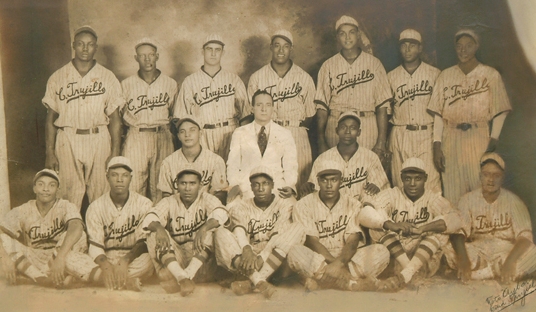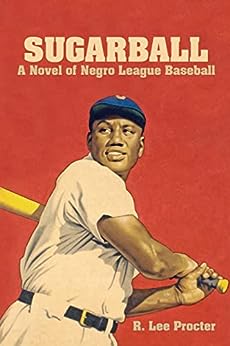Scroll Down to Read Today’s Essay
Subscribe to Baseball History Comes Alive for automatic updates. As a Free Bonus, you’ll get instant access to my Special Report: Gary’s Handy Dandy World Series Reference Guide!
Negro League Photo Gallery
Click on any image below to see photos in full size and to start Photo Gallery:
My Review of:
Sugarball, A Novel of Negro League Baseball
Those of us who are life-long baseball history aficionados usually confine our reading to baseball biographies and other similar non-fiction baseball books. So it’s not often that we venture into the realm of historically-based novels. It’s also not often that we encounter one such book from this genre that happens to be right up our alley.
Many thanks to author R. Lee Procter for sending me his novel, Sugarball: A Novel of Negro League Baseball (Black Rose Writing, 2022). In his email to me, Rich described it this way:
“I’ve written a novel-based-on-an-astonishing-but-true incident, in this case, the sojourn that nine Negro League legends made to the Dominican Republic in 1937. They found themselves enmeshed in a nightmare political scenario where their patron, Dominican President (read dictator) Rafael Trujillo told them that if they didn’t win the last game of the tournament, they’d be killed.”

(In the 1937 photo above, we see Josh Gibson, top, far left; Louis Tiant, Sr., top, 4th; Satchel Paige, middle, far right; Leroy Matlock, front, 2nd; Cool Papa Bell, 4th; Dave Bankhead, 5th)
That intriguing introduction caught my attention. I was familiar with the cast of characters involved, and even had a vague recollection of the incident in the Dominican Republic Rich was describing. Now that I’ve finished the book (in only a couple of days), I can tell you that it was a fascinating account of a truly frightening event. The fact that it was based on a true story makes it even more compelling.
Rich begins the novel with a shocking retelling of the appalling, inhumane conditions encountered by Negro ball players back in the Jim Crow days of the 1930s and ‘40s. Often, while on their interminable road trips traveling from city to city in rickety buses, they would be denied the basics of subsistence, including even food, water, and shelter. They would be subjected to the most overt and humiliating racism. Quite often their only option was to camp out overnight while satiating their hunger with barely edible “hobo stew.” Encounters with Klansmen were common.
Much of this is known to lifelong baseball history fans like us, but it’s still hard to fully digest the magnitude of these injustices from our distance of nearly a hundred years. It’s hard to fathom that such apartheid-like conditions actually existed in the United States of America. And yet, as Rich Procter makes clear, the Negro League players endured these hardships — along with the scant pay they received — purely out of love for the game and the camaraderie baseball afforded them. Those were recurring themes often mentioned by many former Negro League players when recalling their travails from the pre-Jackie Robinson days.
During one such overnight encampment scene, the players were sharing the site with equally-shunned members of Cab Calloway’s orchestra. Suddenly, seemingly out of nowhere, they are approached by one Dr. Enrique Aybar. He is seeking to enlist the greatest Negro League players, including Josh Gibson, Satchel Paige, and Cool Papa Bell, to play on the team of Dominican Republic dictator, Rafael Trujillo, in a national tournament. Enticed by the allure of a big payday, and after much debate, including the persuasive, greed-oriented arguments of Satchel Paige, they naively accepted the agreement to play in the Dominican Republic. It was an agreement they soon came to regret.
Without revealing all the details, suffice it to say that there was a whole lot more to the bargain than they anticipated: multiple encounters with attempted murder and threats of lifetime imprisonment. The stark realization soon seeped in that should they lose the tournament, they would lose a lot more than just mere baseball games. To make matters worse, it became apparent that the “other team” was composed of Cuban All-stars and ringers, not the rag-tag locals they had expected.
Josh Gibson emerges as the hero of the novel, a man who refuses to compromise his integrity even in the face of death. As for the bombastic Satchel Paige, let’s just say he doesn’t fare quite as well. Along the way, we learn of the rivalry that existed between these two great stars and what motivated each man. For Paige, it was pure, unadulterated greed; for Gibson, it was adherence to principles when confronted with the most dire adversity. Cleverly narrated in the first-person account of a fictional batboy nicknamed Peanut — befriended and guided through the ordeal by his protector and mentor, Josh Gibson — the story becomes emotionally gripping.
The author does a remarkable job detailing both the athletic prowess of Josh Gibson, known among his peers as the black Babe Ruth, and his qualities as a man of character. As for his ability as a ball player, Hall of Famer Larry Doby once paid him the ultimate tribute:
“Josh had the power of Babe Ruth and the hitting ability of Ted Williams. One of the things that was disappointing and disheartening to a lot of the black players at the time was that Jackie Robinson – although a great player – was not the best player. The best was Josh Gibson. I think that’s one of the reasons why Josh died so early – he was heartbroken.”
I enjoyed reading the author’s account of one matchup between Gibson and the great Cardinal pitcher, Dizzy Dean, during one of their many barnstorming encounters. The words are put in the mouth of Peanut who observed the confrontation first-hand. He describes the action as Josh takes Dizzy deep:
CRACK! It’s not a sound other hitters make, even home run hitters. That’s ‘horsehide meets hickory,’ you can hear it in every park and sandlot in America. This sound is like the first crack of thunder during a rainstorm —the one that makes you jump three feet in the air. Ducky Medwick, the All-Stars left fielder, doesn’t even run toward the fence. He just turns and watches the ball as it disappears over the fence, still zooming skyward. Then, as one, the fans — all of them, black and white —are on their feet. The black fans are cheering. The white fans are staring, mouths open. Everything they’ve heard — it’s all true.
Sugarball is well-written and incorporates much of the vernacular of the 1930s. The intriguing storyline will keep the reader turning the pages. Rich Procter has done his homework with his ten years of quality research on full display. As primarily a non-fiction reader, I found it refreshing to read. I also enjoyed the end section where Procter addressed questions of fact vs. fiction in the book, many of which I had been thinking about as I read it.
If you’re looking for a baseball book that’s just a bit different from your normal fare and one that will hold your attention from beginning to end, this is the book for you. It’s one that I can heartily recommend.
Gary Livacari
Subscribe to our website, Baseball History Comes Alive with over 1400 fully categorized baseball essays and photo galleries, now surpassing the one million hits mark with 1.062M hits and over 900 subscribers

